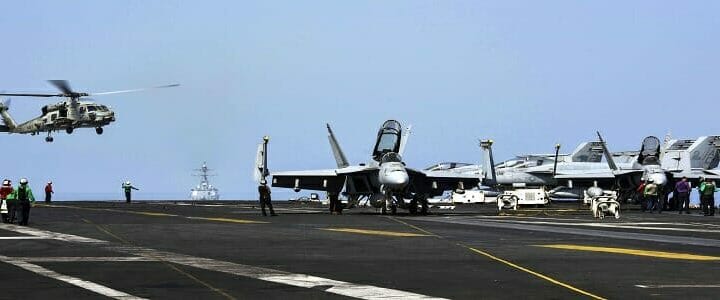The Islamic Republic of Iran is back in the news again – in a big way. After a brief hiatus from the front pages, the land of the Ayatollahs reminded us all just why its been the subject of such crippling economic sanctions for so long.
When President Donald Trump withdrew the U.S. from the Joint Comprehensive Plan of Action – the deal designed to halt, or at least postpone, Iran’s development of a nuclear weapon – it meant that all the old sanctions were going back into place. The government announced the first round in early August; the remaining sanctions will go into effect on November 5.
In addition to those measures, Trump has mulled the possibility of preventing any Iranian oil exports. This has not sat well in Tehran.
Iran is Threatening naval action
Monday, Gen. Alireza Tangsiri, who commands the naval forces of the Iranian Revolutionary Guards Corps, said his fleet is “prepared to defend the waters with their intelligence dominance and monitoring of the enemy’s physical presence.” Most observers take this as a sign that Iran thinks it is capable of closing the Strait of Hormuz, the narrow passage out of the Persian Gulf into the Indian Ocean.
Shortly before the president announced the reimposed sanctions, Iran began a large-scale naval exercise in the Persian Gulf. Iran controls the north side of the Strait of Hormuz. Oman and the United Arab Emirates control the south side. It is an incredibly important chokepoint; although it is 21 miles wide at its narrowest, the shipping lanes are only two miles wide. As much has a third of the world’s supply of crude oil passes through that narrow passage each day.
Iran’s navy is made up largely of small, fast patrol boats whose speed and maneuverability make them challenging to confront. Further complicating matter is the fact that these small boats carry anti-ship missiles. They have made a habit of harassing U.S. warships in the Gulf for a long time. Incidents typically happened a few times a month – until this year.
The Navy released data in early July that reported there were 22 of these incidents in 2015, 36 in 2016, 14 in 2017, and as of today, zero in 2018. The Iranians claim this is because of a change in U.S. behavior. The Iranians don’t specify what this behavior might be, probably because we’ve taken a more aggressive stance towards them.
No carrier in the area, but does that matter?
It can hardly be a coincidence that Iran makes this announcement at a time when the U.S. Navy’s Fifth Fleet, based out of Bahrain, has no large “capital ships” in the Gulf. None of the Navy’s 11 aircraft carriers or its eight Wasp-class amphibious assault ships are in the Gulf, or even in the region.
The USS Iwo Jima returned to its home port of Mayport, Fla. on August 9 after a deployment that included a stint in the Gulf. The carriers USS Ronald Reagan and USS John C. Stennis are operating in the Pacific, as are the amphibious assault ships USS Wasp and USS Essex. They could be in the Gulf in short order, but they’re still not immediately available. There is airpower available onshore, but carriers make it so much easier to operate.
The presence of a carrier might not matter, though. Previously the U.S. government, even under the Obama administration, has said that any Iranian attempts to close the Strait of Hormuz would be considered an act of war. One would assume that policy holds with the significantly more hawkish Trump administration. This is one of the few areas where Trump’s unpredictability is an asset.
The president clearly loves the military and relishes being the commander-in-chief. He loves to boast about American military prowess and wave the “big stick” on the world stage. But at the same time, he is leery of long-term engagement of ground forces. He has pushed for a quick withdrawal from both Syria and Afghanistan. But that does not mean that he would not commit U.S. airpower, or even Marines, to destroying Iranian land-based anti-ship missile batteries.
Any confrontation with Iran could escalate well beyond the area immediately surrounding the Strait of Hormuz. Especially one that aimed to destroy their ability to conduct future attacks on Gulf shipping. Iran’s missile inventory includes two, and perhaps three, models capable of striking Israel. And almost all of their missiles are capable of hitting most of the American military bases in Afghanistan. Both would make tempting targets for the Ayatollahs if they’re backed into a corner.
Trump’s Strategic unpredicatibility
The variety of escalatory options open to the Iranians complicates the U.S. calculus, but not nearly to the degree that Trump’s “strategic unpredictability” complicates that of Iran. They cannot have any reliable way of predicting how the president will react to an attack on a U.S. warship. And in such a case, I wouldn’t count on the ability of Chief of Staff John Kelly, Secretary of Defense James Mattis, or National Security Adviser John Bolton to restrain the president’s impulses. Then again, maybe they would prevail. Iran simply has no reliable way of knowing.
Even the use of nuclear weapons remains a real possibility under Trump, more so than it has been for any other president in recent history. That must be running through the Ayatollahs’ minds. They don’t mind sending the weak-minded to be martyred, but that doesn’t mean they’d like having their entourages stalked by nuclear missiles.
For that reason alone, I think the Iranians will rattle their saber for a few more days, then go back to the status quo. There are worse situations to be in.




